Beth Kanell's Blog, page 16
January 16, 2018
The Weather Inside and Out (A Robert Frost Moment)

As I've listened to guests from around the world coming to explore "America," and especially New England, I've found Robert Frost's poems are among the ones they have most often memorized. People who live around here, in Vermont, also mention two of this California transplant's most significant poems: the one about good fences making good neighbors, and choosing which of two roads to follow (choosing the one less traveled by). In this season of frequent snowfalls and deep plunging temperatures, Frost fans also gravitate to the poem about the man who stops his horse while on errands, and wraps up by saying "I have promises to keep, and miles to go before I sleep."
I have three favorite Frost poems, and one matters a lot to me today: "Tree at My Window." You might be aware that it's a violation of copyright to post an entire poem by someone else (actually most people don't know this! I found out when I erred by posting one, blush). So I'll just give the final verse of this Frost poem here, which begins with the poet's persona talking with the tree just outside his window:
That day she put our heads together,Out on the mountainside today, the snow keeps taking different shades of white, oyster, light gray, even a very pale blue, as the clouds thin and thicken again in front of the well-hidden sun. A few snowflakes fall occasionally; steadier snow is expected this evening, when I'll be doing some errands of my own, so I'm paying attention to the forecast. It's a classic January day, but it's also a bit March-ish, that sense that the snow's been here a long time and isn't in any hurry to leave.
Fate had her imagination about her,
Your head so much concerned with outer,
Mine with inner, weather.
Interior weather: I've just let go of a manuscript that's lived in my heart (and on scraps of paper, in notebooks, and on the computer screen) for three years. It's both wonder-filled and terrifying to send it out into the world, where the staff of a publisher will look at it in very different ways from mine.
 At these moments, I usually change the writing room, to find fresh vision and focus for the next effort. I have three books being built now: one just at the starting point, with the title "A Necessary Holiness"; another, poems of prayer and praise, perhaps half assembled; and the third, the set of stories I completed as 2017 raced to an end, where a good two days of rigorous revision should wrap up the project. But you know how life is ... setting aside those two important days will take planning.
At these moments, I usually change the writing room, to find fresh vision and focus for the next effort. I have three books being built now: one just at the starting point, with the title "A Necessary Holiness"; another, poems of prayer and praise, perhaps half assembled; and the third, the set of stories I completed as 2017 raced to an end, where a good two days of rigorous revision should wrap up the project. But you know how life is ... setting aside those two important days will take planning.So the room, especially the desk and walls, become part of the preparation. The photos here show what I've changed -- and where I'm going, I think.
All of this is especially necessary because I'm also stepping into the final 100 days before publication of my new adventure novel The Long Shadow and I'll be talking about that book often ... but the deep digging of the work-in-progress must continue. Wish me luck. No, on second thought, please wish me a well-crafted balance. And good weather.
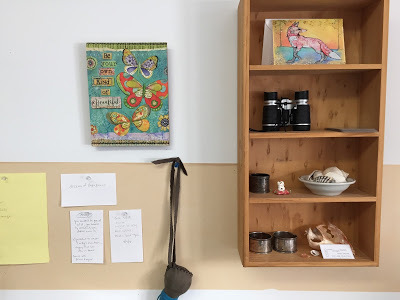
Published on January 16, 2018 09:40
July 30, 2017
This Strange and Exquisite World
 Red eft, courtesy of Vermont Fish and Wildlife.It's good to have "city" company hanging around -- someone who is as astounded by the greenery and the explosions of blossoms as I was when I began garden-tending in Vermont. These many years later, I am still daily astounded, but in different ways: I see things with fresh eyes on the best days, honoring that joy that seems to link our eyes, breath, mind, and soul together. But I also look harder, with questions.
Red eft, courtesy of Vermont Fish and Wildlife.It's good to have "city" company hanging around -- someone who is as astounded by the greenery and the explosions of blossoms as I was when I began garden-tending in Vermont. These many years later, I am still daily astounded, but in different ways: I see things with fresh eyes on the best days, honoring that joy that seems to link our eyes, breath, mind, and soul together. But I also look harder, with questions.In the past week or two I've indulged in evening walks. They are by definition very different from morning ones: The light is fading instead of brightening, the breeze quiets to a whisper, stars begin to show up in the darker segments of the sky. This week there's the arc of a waxing (growing) moon, too; when it's full, we'll start the countdown of another month left before we have to watch for early frosts. But not yet.
Still, the evenings can be chilly here on the mountain ridge. I saw a skunk hump across the road two nights ago, fur fluffed up for warmth. It crossed where I saw the porcupine last week. With this year's questions and hypotheses, I make a guess that the marshy area that lies on both sides of this stretch of road is more than a deer path (I've seen their tracks, no need to guess that part), is also -- maybe because its vegetation is low and soft -- a path for other mammals.
The chill of the evening caused one "crossing creature" to be stranded on the cold road a few evenings ago. Its bright red skin and delicate limbs fascinated me. Definitely a red eft, the juvenile stage of the Eastern spotted newt. Without enough air or land warmth, and without the ability to make its own, the creature stood still, about a quarter of the way across the road. Car alert! Hazardous crossing!
Well, of course talking to it wasn't any use. I tenderly lifted it onto my palm -- the warmth turned the eft into a lively squirming tangle of legs and tail almost immediately, and I had to hurry across the road to release it before my fingers -- so much larger than its limbs! -- would damage it. It immediately hurried into the greenery, vanishing at once. Then I finished my walk, happy to have seen something that so rarely crossed paths with me.
 This week I also read the novel BORNE by Jeff VanderMeer. It's a dystopian novel, set on a world or part of a world where an inventive "Company" has destroyed natural life and seeded the terrain with "biotechs" that can be very threatening and smart. The protagonist, Rachel, sets a new pattern in motion when she gives maternal attention to a bit of tech-made flesh that she takes home -- something that was clinging to the fur of a monster, and which becomes her pet, or her child ... she has "borne" it, and names it "Borne."
This week I also read the novel BORNE by Jeff VanderMeer. It's a dystopian novel, set on a world or part of a world where an inventive "Company" has destroyed natural life and seeded the terrain with "biotechs" that can be very threatening and smart. The protagonist, Rachel, sets a new pattern in motion when she gives maternal attention to a bit of tech-made flesh that she takes home -- something that was clinging to the fur of a monster, and which becomes her pet, or her child ... she has "borne" it, and names it "Borne."The powerful thread that ties the characters and their perils together in BORNE is a question: What is a person? If you love some creature, and it loves you in return, does it have personhood?
(I hasten to say the book does not appear to be indicating anything about the age of personhood for a human fetus or baby.)
Rachel, her friend Wick, and Borne become the testers of their world, determining whether compassionate survival is possible. I like the book; I'd recommend it to anyone curious and questioning and willing to suspend disbelief in what the future of Earth could be. Age 10 and up, I think. It will mean more to adults -- and to those who've read other dystopian novels -- but the tenderness and kindness embodied in VanderMeer's world, page after page, fit the book for skilled younger readers as well. I'm glad it was on that list of "7 Books to Read After ..." (see my earlier post).
Yes, this is how I feed the source of All Good Writing. By reading, exploring, and asking questions. Hope you have a few minutes to explore the rest of this writer's blog.
Published on July 30, 2017 13:50
July 26, 2017
The "Wonder Woman" in My Heart
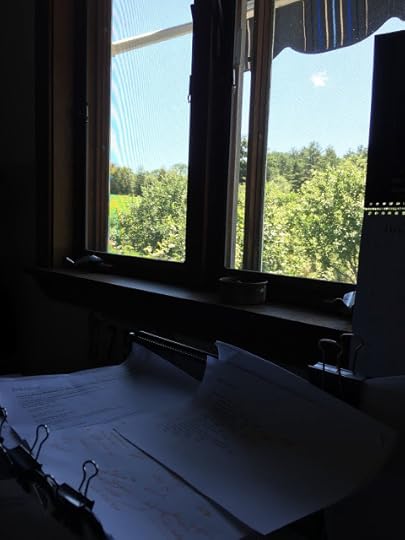 It's been a busy few months -- I resumed writing short stories, thanks to a crazy Saturday spent reading the stories I wrote in the 1980s that I'd forgotten all about. Still pushing daily for the "handles" of entry into the poems for a collection of "Pleas and Praise/Prays." And, of course, editing (my income-earning task). Hiking the ridgelines. And tending the gardens.
It's been a busy few months -- I resumed writing short stories, thanks to a crazy Saturday spent reading the stories I wrote in the 1980s that I'd forgotten all about. Still pushing daily for the "handles" of entry into the poems for a collection of "Pleas and Praise/Prays." And, of course, editing (my income-earning task). Hiking the ridgelines. And tending the gardens.But above all, this season took me back into my newest novel, which Five Star/Cengage will release in April 2018: THE LONG SHADOW. Working with an insightful editor, I didn't just tidy up loose ends (fresh eyes help so much!). I looked into my heart to discover why I wrote this book, in which three teenage girls in 1850 confront Vermont's confusing mixture of attitudes toward abolition ... try to take care of each other ... and suffer the consequences.
As I wrapped up the responses to the editor, the film Wonder Woman arrived at the local theater. By that point, I needed to catch up on editing again, though, and with a sense of loss, I missed the chance to see the movie. (Hope I'll catch it in a few months when it's on a streaming service.) The reviews made it clear to me I'd missed a really good one -- one that asks questions about what it is to be both a woman and a hero. The questions I tackle in every book, story, and even poem that I write.
So when I saw a related list online, "7 Books to Read After Watching Wonder Woman," I figured I'd at least start tucking those books into my evening reading hours. My fabulous local librarian, Jen, tackled getting the books with enthusiasm and power, and I've just finished reading the one I chose for "first": AMERICAN WAR by Omar El Akkad (publisher's author website here; public radio interview, not so great but still interesting, here).

What a novel! Dystopian in the sense that The Hunger Games series is ... featuring a strong and relentless woman ... set in the American South, which I always realize is like another country, for this Yankee woman to visit ... and testing what people will do to each other in the name of politics and manipulation, as well as love.
Most important to me at the moment is also the detail that the woman of interest in AMERICAN WAR, Sarat Chestnut, is dark-skinned, tall, and with frizzy hair, and loved wholeheartedly by her not-identical twin sister, who is shorter, light-skinned, and has the smooth hair that I always envied in my own sister. (It's the little things, it's always the little things. My sister will read this -- her courage astounds and touches me. Meanwhile many Other Big Things sneak up on us, in fiction and in life.)
What will our nation be like after climate change forces the seas to rise above the coastal cities? How will religion-based terrorism ever resolve? Will our nation of 50+ interdependent states remain United? And what do we exchange, for the satisfaction of following through on our own longing to become Wonder Woman within the bounds of our very diverse lives?
AMERICAN WAR spoke insistently to me. I expect some of the echoes to penetrate what I write next: the sequel to THE LONG SHADOW (already underway), the prayer/praise collection, the long work on aging, the very personal novel I'm working on for an editor who trusts my ability to get there in the end. There are things worth crying about. And many, many people worth supporting, as we all struggle to make a good life, one that's honest and deep and caring.
Onward.
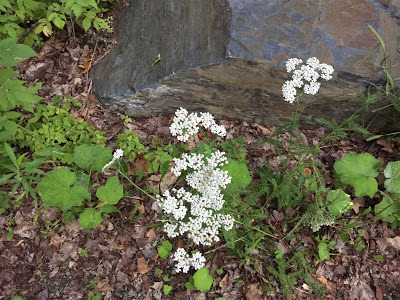
Published on July 26, 2017 09:06
March 18, 2017
Vermonters in Washington, DC, November 7, 1973
 Maybe you are old enough to remember those days? The Vietnam War was a hot topic -- it was supposed to end in early 1973, when the Paris Peace Accord was signed, but the fighting continued. It would finally be over in April 1975, when Saigon would fall to North Vietnamese troops. But who knew that then?
Maybe you are old enough to remember those days? The Vietnam War was a hot topic -- it was supposed to end in early 1973, when the Paris Peace Accord was signed, but the fighting continued. It would finally be over in April 1975, when Saigon would fall to North Vietnamese troops. But who knew that then?Everyone had a strong opinion, from living with the war and its effects for so many years. Technically it began around 1955, but the United States had advisors in place as early as 1950. Those who lived through it recall the escalation in 1964 with the Gulf of Tonkin incident, and the 1968 Tet Offensive when the war reached a terrible peak of action.
Strong opinions? Vermonters had plenty. George Aiken, formerly Vermont governor and then Vermont's Republican Senator from 1940 onward, served as "Dean of the Senate" and tried to bring others together toward right action. Wikipedia's article on Aiken says this:
Aiken took an ambivalent position on the Vietnam war (1965–75), changing along with the Vermont mood. Neither a hawk nor a dove, he was sometimes called an "owl." He reluctantly supported the Gulf of Tonkin Resolution of 1964, and was more enthusiastic in support of Nixon's program of letting South Vietnam do the fighting using American money. Aiken is widely quoted as saying that the U.S. should declare victory and bring the troops home. His actual statement was:
"The United States could well declare unilaterally ... that we have 'won' in the sense that our armed forces are in control of most of the field and no potential enemy is in a position to establish its authority over South Vietnam," and that such a declaration "would herald the resumption of political warfare as the dominant theme in Vietnam."He added: "It may be a far-fetched proposal, but nothing else has worked."
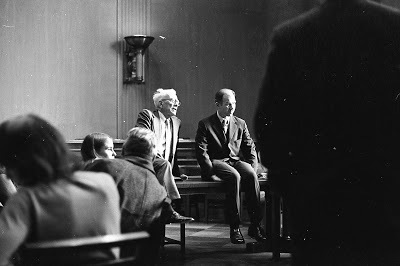 Lunenburg resident Mike Fournier watched the U.S. government's struggles with the war in the 1970s. He wasn't yet a journalist, but with others from Vermont, he journeyed to the nation's capital to see Senator Aiken in action and received his own Senate Pass for November 7, 1973. The photos he took are shown here for the first time; the energy that the white-haired Vermont Senator brought to his task is unmistakeable.
Lunenburg resident Mike Fournier watched the U.S. government's struggles with the war in the 1970s. He wasn't yet a journalist, but with others from Vermont, he journeyed to the nation's capital to see Senator Aiken in action and received his own Senate Pass for November 7, 1973. The photos he took are shown here for the first time; the energy that the white-haired Vermont Senator brought to his task is unmistakeable.We think of Senator Aiken especially in March, because on March 24, 1949, when he was 57 years old, he made a speech in Lyndonville, Vermont, in which he used the term "Northeast Kingdom" to describe our part of the state. It wasn't the first time the name had been used -- Lyndonville resident Arthur W. Simpson and Newport publisher Wallace Gilpin used it in the 1940s -- but even back in 1949, when George Aiken said it, people listened.
And so the Northeast Kingdom accepted its name.
Many thanks to Mike Fournier for sharing these 1973 photos with us.
If you are in the mood to celebrate Northeast Kingdom Day this year, you can leave a comment here, of course -- but if you are close enough to northeastern Vermont, please join us on Friday March 24 at 9 a.m. at the Grindstone Café in Lyndonville, where we'll share what makes the region special, swap some memories or reflections on George Aiken, and lift our mugs of coffee or tea to this place: The Northeast Kingdom of Vermont!
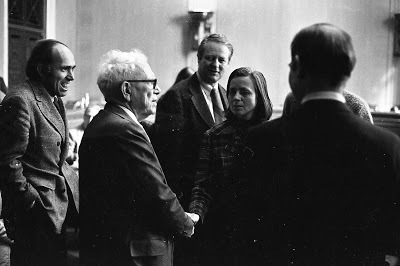
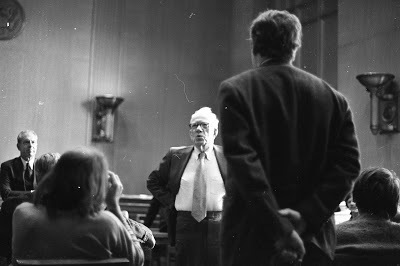
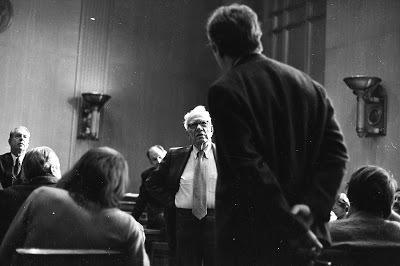
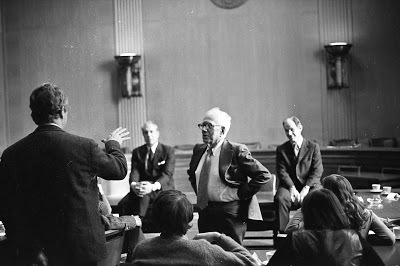
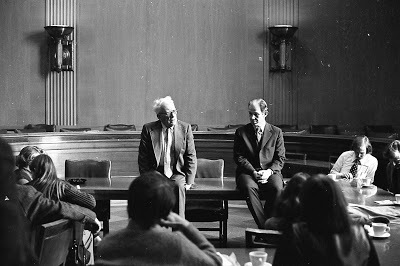
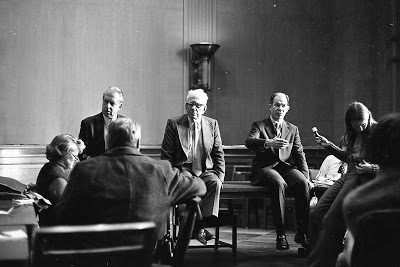
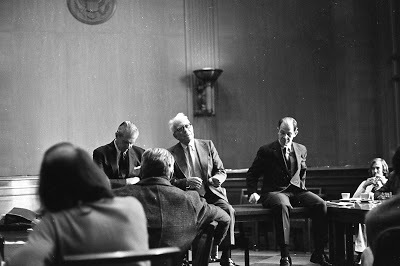
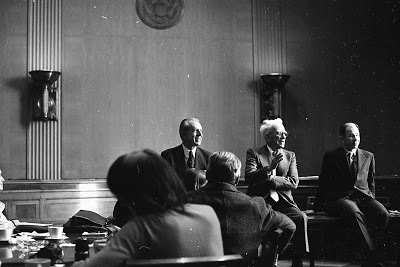
Published on March 18, 2017 10:52
November 30, 2016
The Portrait That Lied: How a Novel Begins
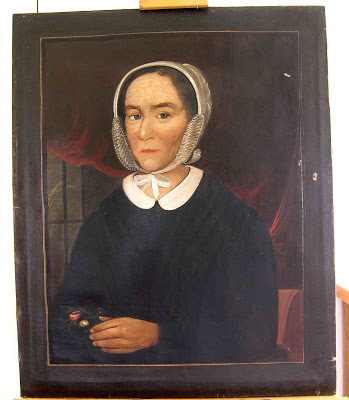 When I was a child, a dark and scary oil portrait hung over my mother's armchair in the living room. This was the 1950s; she sat there with her latest library books to devour, chain smoking cigarettes and appreciating her instant coffee, sometimes fortified. We kids all knew the painting was some ancestor of hers, but we weren't much interested. Besides, my youngest brothers swore the woman's eyes followed them when they ran through the living room. (More likely Mom's eyes-on-the-back-of-her-head, as she said, kept tabs on what they were up to.)
When I was a child, a dark and scary oil portrait hung over my mother's armchair in the living room. This was the 1950s; she sat there with her latest library books to devour, chain smoking cigarettes and appreciating her instant coffee, sometimes fortified. We kids all knew the painting was some ancestor of hers, but we weren't much interested. Besides, my youngest brothers swore the woman's eyes followed them when they ran through the living room. (More likely Mom's eyes-on-the-back-of-her-head, as she said, kept tabs on what they were up to.)When a fine-arts restorer cleaned the portrait a few years ago, details emerged that shocked me.
I knew, by then, that the person in the portrait was named Eleanor, and she was Mom's great-great-great-grandmother. But taking the painting out of its battered frame revealed the painter's signature, and his note of when it was done, along with the phrase, "from a profile." The date turned out to be two years after Eleanor died ... and "a profile," I'm sure, meant one of those black paper silhouettes I tried making as a kid. And the year, of course, was before photographs were common.
When I learned more about the painter, I found out that he commonly painted "postmortem" portraits. He had assistants create a background, and he used his own sense of the person (and that person's community standing) to create a face to set into the center.
Whoa! All the little details came together at last and I realized that (despite one of my cousins always insisting that great-great-great-etc. Eleanor looked like her) the image in the portrait is entirely made up -- it's fiction! Or, as a more critical historian might say: It lied.
Now, I'm already working on a couple of other novels. That's just how it goes. It takes so long to do research, and see the heart of the upcoming book, that there is always something getting into first draft, something else being revised toward publication, and something just starting in the dark ... and some day it will be time to craft a story (probably a novel, but maybe nonfiction after all) about Eleanor. In spite of her portrait being "fiction," I want the American history in the eventual book to be both accurate and insightful.
Cut to the Presidential campaign of 2016, and First Lady Michelle Obama pointing out that she's been living for almost eight years in the White House -- an elegant structure built, in large part, by the labor of enslaved Black Americans. Look also at the past few years of news that have raised the cry that Black Lives Matter, something worth thinking about often as we confront the tilted statistics of who's serving prison time for what crimes. (Vermont's not exempt from those statistics, although I hope we try very hard to earn justice.)
Why think about those things now? Well, Eleanor was born less than 20 years after the Declaration of Independence was signed. She made her living, eventually, from the shipping trade, which for America often included shipping humans. So I have to ask: What part did America's dreadful enslavement of millions of its forced immigrants (and others) play, in Eleanor's life and success -- and in the lives of her own ancestors?
And that's part of why it takes so long to do the really good research. Uncomfortable questions like this one push me to read and learn at a level I would have considered "too much homework" in high school and even college. I'm now reading Wendy Warren's shocking, horrifying book New England Bound: Slavery and Colonization in Early America. She makes it clear that in the 1600s in New England, enslavement of people -- both African and Native American -- was expected and profitable. I'm checking all the names she mentions, against those in the family tree. So far, no direct matches.
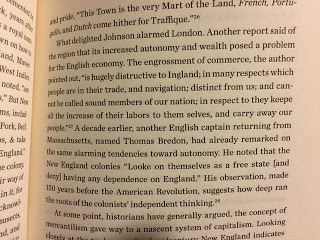 from New England Bound, by Wendy Warren
from New England Bound, by Wendy WarrenBut I'm sure there's darkness back there. And for this writer, that's where we start: in the darkness, facing it honestly, and hoping that courage and wisdom and love will help build a route toward the light.
* * *
Five Star/Cengage is publishing my next book, The Long Shadow, in 2017 (date not yet set). It can't be a coincidence that the novel, set in 1850 in a nearby Vermont town, begins with an argument over enslavement as a moral disaster and a political divider. Slavery's long, dark shadow ...
Published on November 30, 2016 08:38
October 29, 2016
A Vermont Halloween-Season Connection
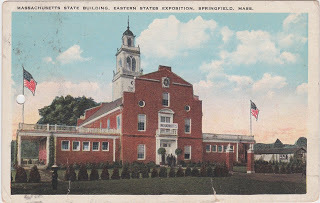
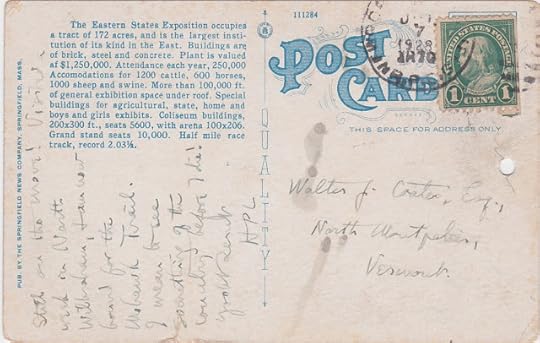 Pumpkins are sprouting on doorsteps, silhouettes of witches dance in the breeze, and kids are intently trying on and reconsidering costumes -- it's almost Halloween.
Pumpkins are sprouting on doorsteps, silhouettes of witches dance in the breeze, and kids are intently trying on and reconsidering costumes -- it's almost Halloween.For those attached to Vermont's history, it's also almost November 3: 89 years since the great flood that devastated so many of Vermont's roads, bridges, and homes in 1927. The flood damage lived well beyond the normal lifetime of such disasters, as it took root in the fertile imagination of a writer named Howard Phillips (H.P.) Lovecraft. Lovecraft first visited the Green Mountains in 1928 at the invitation of his friend Vrest Orton, a prominent publisher and businessman (and founder of the Vermont Country Store).
To H.P. Lovecraft, Vermont was a wild place -- lovely, yes, but also with the potential for the dark, the frightening, the weird. He carried the scary side of his mixed impressions into his writing, creating a story called "The Whisperer in Darkness." We would now call the tale "speculative fiction" but for many years it was simply seen as horror: the genesis, in fact, of today's best horror writing.
Lovecraft's long career included many more brilliant stories, and he also served on the board of a "little literary magazine" of the period called Driftwind, where the publisher and editor in chief was Walter P. Coates of North Montpelier. Issues of Driftwind that include Lovecraft's own writing, mostly poems, are treasured highly.
A collector of Lovecraft writings and related documents is allowing me to display today's images of the front and back of a postcard sent by Lovecraft to Coates, an amazing item that portrays the working relationship of the two men. Many thanks for the permission to show these.
[Transcription: Still on the move! Visited a week in North Wilbraham, + am now bound for the Mohawk Trail. I mean to see something of the country before I die! (illegible) HPL] [Postmark date appears to be Oct 7 1928; the Mohawk Trail is a major road across northwestern Massachusetts.]
And if you have a Lovecraft reflection of your own, please share it in a comment on this piece.
Published on October 29, 2016 12:22
February 28, 2016
Country Life in March -- Mud Season, Gardens, and Big Plans
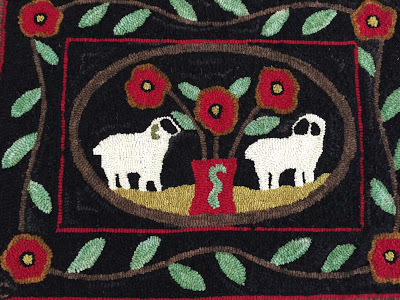 When I'm planning a novel, I start with a lot of fragments: moments and phrases and bits of the landscape that shine, with that soft sort of gleam you get after polishing a silver teaspoon (not as "glaring" as the shine on a freshly cleaned smartphone screen). They tug at me, insisting that they belong in a story. And those are just the inanimate items. The characters and their lives, as they grow rounded and real, bump into me more and more often in each day -- while driving, while waiting for the oven timer to ding, while in the shower (one of the very fruitful moments, except for the necessity of holding the character's action in mind until my hands are dry enough to grip a pen and scribble things on paper without dripping).
When I'm planning a novel, I start with a lot of fragments: moments and phrases and bits of the landscape that shine, with that soft sort of gleam you get after polishing a silver teaspoon (not as "glaring" as the shine on a freshly cleaned smartphone screen). They tug at me, insisting that they belong in a story. And those are just the inanimate items. The characters and their lives, as they grow rounded and real, bump into me more and more often in each day -- while driving, while waiting for the oven timer to ding, while in the shower (one of the very fruitful moments, except for the necessity of holding the character's action in mind until my hands are dry enough to grip a pen and scribble things on paper without dripping).Right now I'm in chapter 2 and chapter 5 of two different novels, so my mind and my writing room are cluttered with tidbits that have to fit someplace. I don't always know why, but I know they belong.
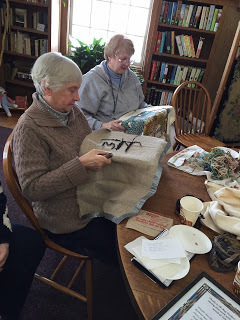
Yesterday I drove about 40 minutes north of here to a gathering of the Northeast Kingdom Rug Hookers Guild. I enjoyed watching the dynamics of this group of strong, creative crafters (including a boy maybe 12 years old who pounded out classical music on the piano in the room across the hall; he was someone's son). Many of the rugs featured wool, cut into thin strips, being "hooked" into the backings to create images. Some used yarn; one came from slivers of T-shirts.
Two rugs in particular featured sheep, and sheep have been on my mind. Like the rugs, I don't think the sheep are moving into either of the novels (but they might!). Instead, I can feel them moving into my garden plans for the year.
I should clarify: It's the last weekend of February, and March is about to roar into place. In this part of Vermont, the Northeast Kingdom, March weather means chaos: abrupt rainstorms, unexpected snow deliveries that often add up to a foot or more, and most of all, the insistent bright sunshine that heats the frozen ground, creating thick layers of mud where the roads and gardens expose the naked ground to the new seasonal warmth. We call it Mud Season.
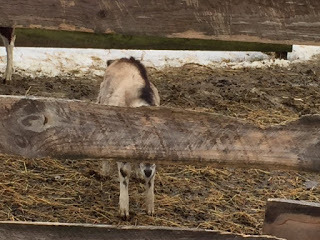
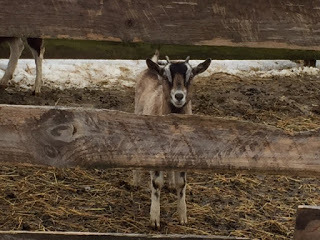
It's also the season for ordering seeds to plant, which means some notion of this year's vegetable garden must emerge from the winter fog. And for those with active animal housing, it's lambing season, and time to order chicks (they arrive via the mail carrier, a dozen or more to a box, peeping), and more calves than usual arrive in the dairy barns.
So as all the sheep and wool items around me cascade, like bits of an upcoming novel, I start to wonder ... should I be planning a lamb into my garden this year? A couple of sheep? I can almost picture them grazing the surrounding lawn. Then I start to add up the daily feedings, the care of hooves and ears, the vet visits, and I remember that our shed isn't a good enough barn.
No, just as for the novel-in-progress, some ideas need to be set aside. Admired, yes. But declined this time. It occurs to me that it might be a good nod to March, though, to visit some local sheep breeders. And goat herders. Ah, that fits better. In fact, I think there's a tie to one of the twists in novel #1 in such a visit.
That's what I like about country life. Keep something around for a while, and it will come in useful. One way, or another.
* * * * *
Below: Sheep article from Vermont History News, Sept.-Oct. 1983
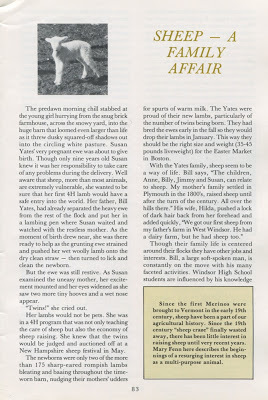

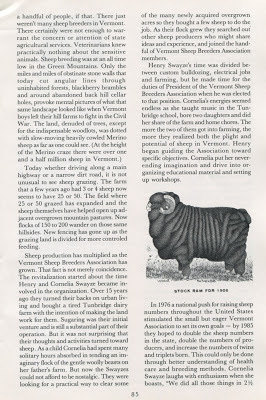

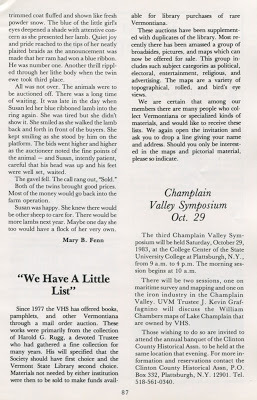
Published on February 28, 2016 09:36
January 20, 2016
Nature or Nurture? Justice, Secrets, and Love
A few weeks ago, through a connection with a cousin of mine in Israel (Inbal Jaffe), I received a photo that apparently has been legendary in my family's history. I didn't know it existed until Inbal attached it to an e-mail, but another cousin, Phillip Minden, told me he'd long searched for it. When I saw it, I looked from left to right at the "Three Henry Mindens" in the picture -- noting Dr. (of law) Henry Minden in the center, a man whose generous life I've recently learned about -- and suddenly realized the man on the right was "my" Henry Minden, a man who lived on Long Island when I was a child growing up in New Jersey. More than anyone else, more than my "real" grandparents, who all lived in England, this Henry Minden did for me and my siblings what grandparents do for their grandchildren: He welcomed us at holidays and on Sunday afternoons, hid Easter eggs around the garden for us to find (even though he was Jewish), encouraged us to play musical instruments, and gently assured us that a life of books was a very good life.

As I grew older, my parents revealed a small bit of Henry's story: He and his wife Betty had escaped Europe during the Second World War, via Holland, they said. Later, when I read the story of Anne Frank, I thought maybe they had hidden there, and been sent out secretly. But I didn't ask for more details -- in the family where I grew up, some things you didn't ask about, and most of those had to do with the War and the Camps ... the concentration camps.
Henry died while I was a teen, and I had never been to a funeral. Struggling to read my father's face when he asked me in a neutral tone whether I wanted to go to Henry's, I said, "No thank you." I think my father's relief related to not having to explain to me what I might have heard at that funeral. It was the family's job, as he saw it, to put the sorrow of the past behind, and not speak of it.
So it was that when I turned 50 years old, I knew almost nothing of my father's side of the family. He had said, to the child I was once, that "nobody close" to him had perished in the camps, or the war.
Yet the man with whom I courted that year (and soon married) said to me, "I think your father's family name is in the books in my personal library of Jewish life and history." So, far too late to ask for details from my deceased dad, I learned something in those books of Henry Minden after all ... and put into perspective the crumbs I had kept about my grandfather Ernest, who was my father's father. It took more years before I realized that I also had important "crumbs" to investigate about my father's mother, Lena.
And then everything I thought I knew about my father's family fell apart, as I found that Lena's father (I have a photo of him with my dad!) apparently perished in Auschwitz in 1942; just last year, I learned of my cousin Max who died fighting for "our side" in Italy; and now I think I've found another close member of the family who may have died in the war.
But here is what I know for sure: Henry Minden number 3, the Henry on the right, was a kind man with a deep love of art and music, and who loved me. My father's family helped many others to reach safety and justice during the war, and afterward. And, as I have slowly come to realize, my mother's own repeated mention of Quakers in her family turned out to be a link to others who wrestled for safety and justice in America's long history -- whether in New England or New Jersey or Philadelphia.
Now I have this heritage, shakily assembled, slowly becoming more certain, of justice seekers and, put politely, secret keepers. I find that there's some of each of those in me, after all, and in my writing.
But most of all, as I realized last week, tears running down my face while I gazed at Henry's familiar face, my family has given me love.
Now, bear with me one more paragraph for an announcement: I am enormously delighted to say that the small local library in my town here in Vermont, the Davies Memorial Library, is acquiring a collection of books on social justice next month. Here are some details -- and I am happy to say that I've had a role in helping this come together:

As I grew older, my parents revealed a small bit of Henry's story: He and his wife Betty had escaped Europe during the Second World War, via Holland, they said. Later, when I read the story of Anne Frank, I thought maybe they had hidden there, and been sent out secretly. But I didn't ask for more details -- in the family where I grew up, some things you didn't ask about, and most of those had to do with the War and the Camps ... the concentration camps.
Henry died while I was a teen, and I had never been to a funeral. Struggling to read my father's face when he asked me in a neutral tone whether I wanted to go to Henry's, I said, "No thank you." I think my father's relief related to not having to explain to me what I might have heard at that funeral. It was the family's job, as he saw it, to put the sorrow of the past behind, and not speak of it.
So it was that when I turned 50 years old, I knew almost nothing of my father's side of the family. He had said, to the child I was once, that "nobody close" to him had perished in the camps, or the war.
Yet the man with whom I courted that year (and soon married) said to me, "I think your father's family name is in the books in my personal library of Jewish life and history." So, far too late to ask for details from my deceased dad, I learned something in those books of Henry Minden after all ... and put into perspective the crumbs I had kept about my grandfather Ernest, who was my father's father. It took more years before I realized that I also had important "crumbs" to investigate about my father's mother, Lena.
And then everything I thought I knew about my father's family fell apart, as I found that Lena's father (I have a photo of him with my dad!) apparently perished in Auschwitz in 1942; just last year, I learned of my cousin Max who died fighting for "our side" in Italy; and now I think I've found another close member of the family who may have died in the war.
But here is what I know for sure: Henry Minden number 3, the Henry on the right, was a kind man with a deep love of art and music, and who loved me. My father's family helped many others to reach safety and justice during the war, and afterward. And, as I have slowly come to realize, my mother's own repeated mention of Quakers in her family turned out to be a link to others who wrestled for safety and justice in America's long history -- whether in New England or New Jersey or Philadelphia.
Now I have this heritage, shakily assembled, slowly becoming more certain, of justice seekers and, put politely, secret keepers. I find that there's some of each of those in me, after all, and in my writing.
But most of all, as I realized last week, tears running down my face while I gazed at Henry's familiar face, my family has given me love.
Now, bear with me one more paragraph for an announcement: I am enormously delighted to say that the small local library in my town here in Vermont, the Davies Memorial Library, is acquiring a collection of books on social justice next month. Here are some details -- and I am happy to say that I've had a role in helping this come together:
Tuesday February 16, Educating Ourselves About Social Justice, at the Davies Memorial Library in Lower Waterford at 6:30 p.m. LSC Professor Patricia Shine and several of her students present and discuss some of the most influential titles on social justice. Books available from the library afterward. Free and open to all. Info: 748-4609 and davieslibraryvt@gmail.com
Published on January 20, 2016 15:42
November 7, 2015
New Poems: BACK TO THE GARDEN
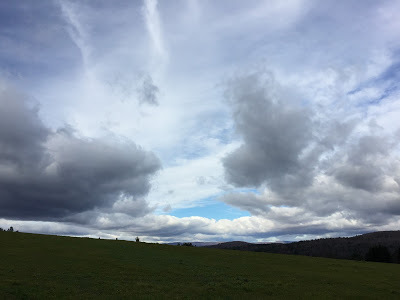
The series is piling up nicely. These are first drafts; I won't go to revisions for a while yet. I love the way first drafts pile up, like raked leaves, that same dry scent ...
The scent of the autumn woods, a leafcaught in my hair – did we choose the place,or did it pull us relentlessly (it was alwaysmeant to be: this hunger you wake in me,this place in the chest where October lives).Once upon a time I thought each questionhad to be asked. Now, I only want your mouthagainst mine, your pulse, this answer,real as the twig caught against my shoulder.Say “maple.” Say “birch.” Say “yes.”
-- BK, 10/30/15 A Visit to the Old Place
Every year around this timewith the harvest in, oats, carrots, applesdry leaves crunching underfootwe pull the truck out of the barn.There is room behind the seats for the big thermosand sandwiches, whose fragrancefills the space between us: garlic, onion, salt(oh yes, salt asserts its own fragrance)and behind us the house diminishes untilthe road bends – we enter that wildernessof need and complaint. Why would God inventtraffic jams, road construction, yellow diggerssurrounded by supervisors in orange vets –things we have not missed during our autumn.But we missed the home place, the well of grace.He drives. I comment. “Things have grown up so much.”
There’s no answer to change, except to grow applessomewhere else. Shopping mall, parking strip,cluster of seedy brick shops. Declare MacIntosh. Cortland.Golden Delicious. Are we there yet? He watchesthe odometer, brakes, says “Here. It was here.”One iron gate hangs loose from a stone pillar,broken pavement beyond it. A red plastic cup and
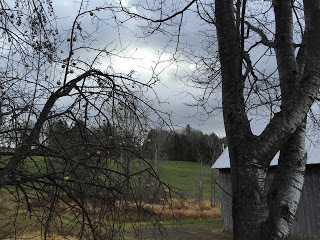 crumpled paper on shattered tarmac. Leafless branchesbare and thin as arms escaping a white gown. Some sad smell.“The angel stood: there.”
crumpled paper on shattered tarmac. Leafless branchesbare and thin as arms escaping a white gown. Some sad smell.“The angel stood: there.”-- BK 11/7/2015
Hungry During Deer Season
Going “back to the land” meant hunting: the awkward feelof cold steel, balancing the rifle, checking the calendar.That first season of daily hunts, though, the man in my lifedid everything the hard way. No snow to track with.No high-tech clothing for warmth. Each day, perched in a treewith a bow and arrows, tested at the suburban archery range.And on the last day of the season, mid afternoon,he ran breathless out of the forest, arms waving, stumbling:“Come with,” he gasped, “need you. Carry.”I wrapped my coat around my swollen belly and followed.
It was a small deer, as deer go. But male, and with antlers,and the paper tag already fastened to the corpseas if it needed a toe tag but the hoof couldn’t cooperate:body, cooling, heavy with the day’s grazing. Close up,it wasn’t Bambi at all, but coarse-haired, wild, muscled.“Take the front legs,” my hunter directed me. “Don’t bumpthe head into any trees. Lift.”
Even dead, the round eyes shone, ready to capturethe last sunlight. The sun sank into cold twilight and we lifted, tugged, staggered. How heavy it was,that awkward, stiffening body. When I stumbled,he cried out, “Careful! Don’t hurt him!” But my handsneeded to release the hairy skin, the bony leg,needed to rub in habit and comfort againstthe baby bump. Oh child to come, oh little one,already it’s you, most important in my life.Not yet for him, bearing his first deer, his heartwild in triumph and joy – yet the little fists in my bellystruck outward, toward that man becoming a father.
“I need,” I said. “I need to breathe. I need to stopfor a moment to rest my hands.” And my heart.Supper to make, but first the kill to report,and the body to raise high into a tree,its belly slit, its liver sliced and sizzling in a cast-iron pan.
From here onward, it’s all the other wantsthat I’m hearing. I cook. I feed. When the baby comes,it will be strong, healthy. Hungry.
-- BK 11/6/15
Published on November 07, 2015 18:51
October 31, 2015
"East Village" Vermont Fire of 1912: The True Story
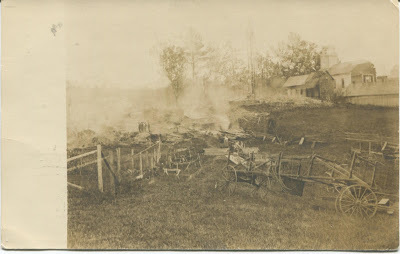 The East Village fire of 1912: remains. Photo taken from behind today's Peter & Polly Park. Look for the bell tower of the church, toward the right rear in the card.Dave and I enjoy collecting old postcards that show locations -- and sometimes people -- around our area, the Northeast Kingdom of Vermont. We've done this since we met, back in 2002, and it's become an important part of the research we each do: Dave for his attention to the college where he worked for 19 years (Lyndon State College) as Assistant Dean of Residential Life (he stays in touch with SO many people, as well as the history of Theodore N. Vail, a founder of AT&T and donor of many of the college town's cultural treasures. And me, well, I'm always hunting down more details of "truth" to add to the historical adventures I write.
The East Village fire of 1912: remains. Photo taken from behind today's Peter & Polly Park. Look for the bell tower of the church, toward the right rear in the card.Dave and I enjoy collecting old postcards that show locations -- and sometimes people -- around our area, the Northeast Kingdom of Vermont. We've done this since we met, back in 2002, and it's become an important part of the research we each do: Dave for his attention to the college where he worked for 19 years (Lyndon State College) as Assistant Dean of Residential Life (he stays in touch with SO many people, as well as the history of Theodore N. Vail, a founder of AT&T and donor of many of the college town's cultural treasures. And me, well, I'm always hunting down more details of "truth" to add to the historical adventures I write.So this postcard became one of our Big Finds for 2015. It is what's called a "real photo postcard" -- someone photographed an actual scene and event, and had the picture made into cards. Three things alerted us to excitement here: the scene, which is after a disastrous fire; the postmark and hardwritten date, August 26 (25), 1912, in St. Johnsbury, Vermont; and the writer, L. D. Weston, who notes that he's writing to "Dear" Mrs. F. Weston, in Marbleton, Quebec, Canada.
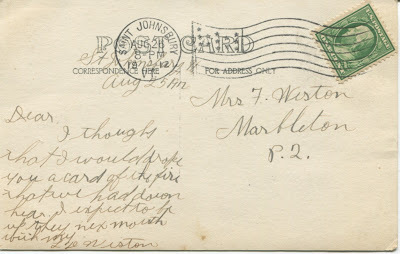
We were wrong in almost all of our early assumptions about the card, though! The name "Weston" immediately rang a bell for us, as we know there's a household including that name in East St. Johnbury today. We wondered whether it was connected to today's family, and whether the image showed a farm fire.
Each of us -- Dave and I -- investigated in different directions. Soon we learned that today's Weston family didn't have a record of someone of that name in East St. Johnsbury (then known as "East Village") in 1912; then we found that L. D. Weston had lived in Lyndonville but was employed for a while by the railroad in St. Johnsbury. Finally Dave used the Library of Congress archives to unearth newspaper coverage of the 1912 fire -- which, oddly enough, turned out to have happened in East Village after all! I typed the news report up, and circled back to Edward Lee's "East St. Johnsbury Vermont" (1984) booklet to confirm the story from another direction. Lee's account makes it clear that the devastation of the East Village fire on August 7, 1912, had three contributing factors: no firefighting system in the village beyond the traditional "bucket brigade"; the fact that when the first motor-powered firetruck in St. Johnsbury itself (some 5+ miles away) tried to reach the fire, it was interrupted (according to the newspaper, three times!) by frightened teams of horses along the route; and a delay in getting a hand pumper from the Fairbanks Scale factory (about 6 miles way) to the fire via the railroad -- the pumper was placed on a flat car for transport along the rail line that linked the two villages, but had to wait for the passenger train from Portland, Maine, to arrive first.
Lee's account also includes the intriguing mention that firefighting villagers considered dynamiting the Moulton house next door to the church to stop the fire from traveling as far as the church! It appears this was a last resort that didn't actually happen.
A final note from Lee's accounts: By 1928 the East Village had its own fire station, next to the large store built a century earlier by Silas Hibbard. Perhaps one of today's readers can tell us when firefighting left East Village again, to be focused in "downtown" St. Johnsbury instead.
Here is the promised newspaper article:
<!-- /* Font Definitions */ @font-face {font-family:"MS 明朝"; mso-font-charset:78; mso-generic-font-family:auto; mso-font-pitch:variable; mso-font-signature:1 134676480 16 0 131072 0;} @font-face {font-family:"Cambria Math"; panose-1:2 4 5 3 5 4 6 3 2 4; mso-font-charset:0; mso-generic-font-family:auto; mso-font-pitch:variable; mso-font-signature:-536870145 1107305727 0 0 415 0;} /* Style Definitions */ p.MsoNormal, li.MsoNormal, div.MsoNormal {mso-style-unhide:no; mso-style-qformat:yes; mso-style-parent:""; margin:0in; margin-bottom:.0001pt; mso-pagination:widow-orphan; font-size:12.0pt; font-family:"Times New Roman"; mso-fareast-font-family:"MS 明朝"; mso-fareast-theme-font:minor-fareast;} .MsoChpDefault {mso-style-type:export-only; mso-default-props:yes; font-size:10.0pt; mso-ansi-font-size:10.0pt; mso-bidi-font-size:10.0pt; mso-fareast-font-family:"MS 明朝"; mso-fareast-theme-font:minor-fareast; mso-fareast-language:JA;} @page WordSection1 {size:8.5in 11.0in; margin:1.0in 1.25in 1.0in 1.25in; mso-header-margin:.5in; mso-footer-margin:.5in; mso-paper-source:0;} div.WordSection1 {page:WordSection1;} </style> --> <div class="MsoNormal">St. Johnsbury Caledonian, August 14, 1912</div><div class="MsoNormal"><br /></div><div class="MsoNormal"><b style="mso-bidi-font-weight: normal;">FIRE IN EAST VILLAGE</b></div><div class="MsoNormal"><b style="mso-bidi-font-weight: normal;">Four Houses and Four Barns Completely Destroyed and other Buildings Damaged.</b></div><div class="MsoNormal"><br /></div><div class="MsoNormal"><span style="mso-tab-count: 1;"> </span>The little village of East St. Johnsbury suffered the worst fire it its history last Wednesday afternoon when in about three hours four houses and four barns were completely destroyed and another house and the Congregational church were considerably damaged. It was a case of no water system and all that save at least three more houses and the church was the sending of a hose cart and a hand pump with several volunteer firemen from this village to assist their brethren in misfortune.</div><div class="MsoNormal"><br /></div><div class="MsoNormal"><span style="mso-tab-count: 1;"> </span>The fire was discovered about half past twelve when smoke was seen pouring out of the roof and along the ridge pole of John Nolan’s house on Main street. All the men in that section were away at their work and Mrs. George Dodge spread the alarm along the street. When the flames burst through the roof the top of the house was all on fire and all it was possible to do was get Mr. and Mrs. John Nolan Sr. out of the house and the family’s furniture, clothing and bedding were all lost. The fire quickly reached the barn which was filled with this season’s cut of hay and everything there was burned. Mr. Nolan received $1930 insurance on the buildings and furniture and that practically covers his loss.</div><div class="MsoNormal"><br /></div><div class="MsoNormal"><span style="mso-tab-count: 1;"> </span>George Dodge’s house stood next to the Nolans and the fire soon leaped across the space and began devouring those buildings. Enough people had gathered by this time to remove most of the furniture and articles from the barn and they were saved in a somewhat damaged condition. The Dodges received $1,000 insurance which practically covered their loss on the buildings. There was a loss of over $200<span style="mso-spacerun: yes;"> </span>on the hay, wood and furniture.</div><div class="MsoNormal"><br /></div><div class="MsoNormal"><b style="mso-bidi-font-weight: normal;">Assistance From St. Johnsbury</b></div><div class="MsoNormal"><br /></div><div class="MsoNormal"><span style="mso-tab-count: 1;"> </span>When it was seen the fire would spread the authorities of St. Johnsbury were telephoned, and they ordered the new automobile fire truck to the scene. The truck had to come to a full stop three times on account of frightened teams and then made the trip in nine minutes. The buildings were so far done before the truck arrived that the chemicals were of no use and as the village had no water pressure the hose could not be used. Word was sent back to St. Johnsbury and an out of town alarm was sounded. The firemen quickly responded and soon had the hose cart with a hand pump loaded on a flat car and with about 20 firemen was ready to start. The special train was held however until the eastbound express pulled out and then was run to East Village. The firemen arrived there about quarter of three and soon had the pump throwing a good stream of water from the river on the fire.</div><div class="MsoNormal"><br /></div><div class="MsoNormal"><b style="mso-bidi-font-weight: normal;">More Buildings Destroyed</b></div><div class="MsoNormal"><br /></div><div class="MsoNormal"><span style="mso-tab-count: 1;"> </span>Before the St. Johnsbury men arrived the fire had swept through the house and barn of Miss Charlotte Morrill a[n]d practically leveled the house and barn of Francis Brown. It had also caught on one side of the buildings of Lois Moulton and an attempt was being made to tear down that house in an effort to keep the blaze from the Congregational church. In their fright the people damaged the furniture considerably and they tore out the pews, windows and carpets of the church and some furniture was taken from the house of Eugene Shasteny beyond the church In a few minutes after the stream from the pump was started it seemed that the blaze would be stopped at the Brown house and the destruction of furniture was stopped.</div><div class="MsoNormal"><br /></div><div class="MsoNormal"><br /></div><div class="MsoNormal"><b style="mso-bidi-font-weight: normal;">Sick People Carried Out</b></div><div class="MsoNormal"><br /></div><div class="MsoNormal"><span style="mso-tab-count: 1;"> </span>During the excitement Mrs. Moulton and Mrs. Shores were nearly overcome by fright and had to be helped to places of safety. Aunt Honor Brown, a woman about 85 years of age who lay in bed with a broken hip, were carried out of the Brown house. George Babcock was quite badly cut over one eye by a piece of furniture which was thrown from a house. The Brown invalids were taken to St. Johnsbury and the whole Brown family are there at present stopping with relatives. The Brown buildings were insured for $800 which covers the loss of them but Mr. Brown lost a lot of nice wood and some furniture. It is doubtful if they rebuild.</div><div class="MsoNormal"><br /></div><div class="MsoNormal"><b style="mso-bidi-font-weight: normal;">More of the Insurance</b></div><div class="MsoNormal"><br /></div><div class="MsoNormal"><span style="mso-tab-count: 1;"> </span>The church was allowed $200 damage by the insurance company and Lois Moulton was allowed $350 insurance which will hardly cover her loss. The loss on the Morrill house was $1,243 but the loss is above $1,600. </div><div class="MsoNormal"><span style="mso-tab-count: 1;"> </span>John Nolan and his family stay through the day at the abandoned house on their farm outside the village, but they stay nights at Charles Bowman’s as they lost all of their bedding. Mr. and Mrs. George Dodge have taken rooms as Oscar Wallace’s and will rebuild their house at once. Miss Charlotte Morrill is stopping with the Rev. Edward Lee and he sister, Mrs. M. S. McCurdy, who was spending the summer with her. is stopping at George Copp’s. Mrs. Moulton is also stopping there until her house is made habitable.</div><div class="MsoNormal"><br /></div><div class="MsoNormal"><b style="mso-bidi-font-weight: normal;">The Morrill House</b></div><div class="MsoNormal"><br /></div><div class="MsoNormal"><span style="mso-tab-count: 1;"> </span>The house of Miss Charlotte Morrill was one of the oldest and best known residences in the village. It was partly built by the Rev. Silas Gaskill in 1825 and completed by Judge Calvin Morrill in 1850. It has been the residence of the Morrill family since the marriage of Calvin Morrill and Sophronia Lee in 1834. The family consisted of one son and three daughters of whom only the daughters, Mrs. M. S. McCurdy of Andover, Mass., Mrs. Elizabeth Chapman of South Part and Miss Charlotte Morrill, a member of the faculty of Adelphi College in Brooklyn, N.Y., survive. For years it has been occupied by the Morrill family as a summer residence where they had entertained many other guests.</div><div class="MsoNormal"><span style="mso-tab-count: 1;"> </span>Miss Morrill plans to rebuilt the house at once. ###</div><div class="MsoNormal"><br /></div><div class="MsoNormal"><i>A final note from Beth: Each of my novels somehow includes a fire, I find ... probably because of the one that made such a change in my own family's life. More on that, some other time. Finally, Dave and I are pretty sure this postcard is indeed of the East Village fire -- but a curious side issue is, it seems to be the only existing image of the fire. So if, after all this, you think we are mistaken and you have a good reason to say the card is of some other place or time ... let us know. We are always learning, and eager to learn more. -- BK</i> </div>
Published on October 31, 2015 11:47



